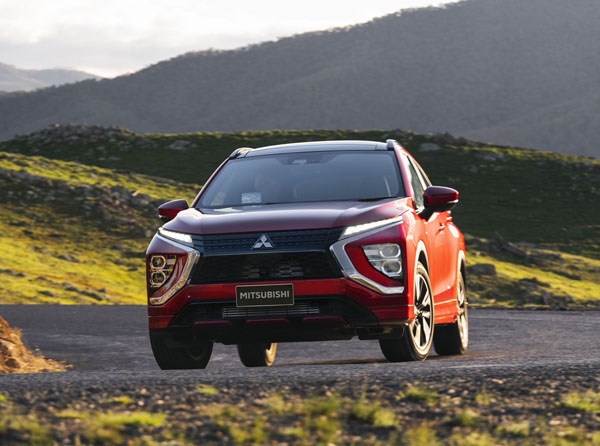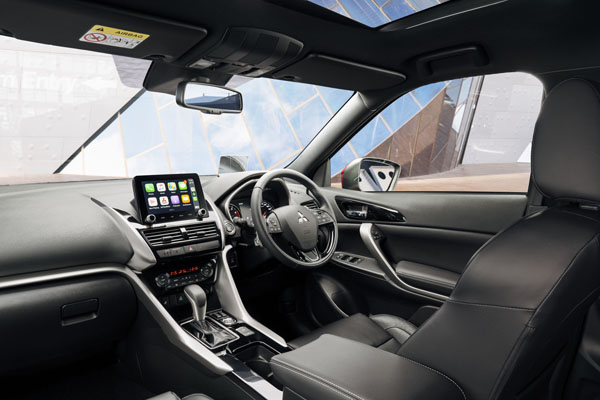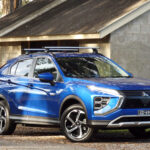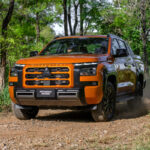
In an attempt to get its Eclipse Cross out of the shadows of more favoured rivals, Mitsubishi has looked to driver comfort and on-road handling, a no brainer in such a competitive market.
For example, front and rear overhangs have been extended in a bid to inject dynamic proportions. Up front, the Mitsubishi Dynamic Shield has evolved with the addition of new headlamps and LED daytime running lights.
The rear has been restyled to create a sleeker appearance in conjunction with the robustness of a traditional sports utility vehicle. Eighteen-inch alloy wheels complete the makeover.
An electronically controlled 4WD system, combined with the maker’s tried-and-tested Super All-Wheel Control, are there to encourage a sense of adventure.
The Eclipse Cross now comes in six variants – ES, LS, Aspire and Exceed – with a mix of two and all-wheel drive powered by a 1.5-litre turbo-petrol engine mated with a continuously variable automatic.

Prices start at $30,290 for the Eclipse Cross ES 1.5L CVT 2WD and run to the top-of-the-range Exceed 1.5L CVT AWD at $40,790. All are plus on-road costs. On test was the mid-range LS AWD 1.5L CVT , selling for $35,090, plus ORCs.
All are covered by Mitsubishi’s ten-year 200,000 kilometre warranty and capped price servicing, provided that all scheduled services are done through the authorised Mitsubishi Motors Dealer Network, otherwise the warranty stays at five years/ 100,000 km. Some customers, such as government, taxis, rentals and selected national business, are excluded.
STYLING
Prestigious profile: a sharp crease running from the front door to a reworked rear lamp assembly helps to emphasise the increase in length (140 mm) of the Eclipse Cross.
However, an overbearing bolder Dynamic Shield design upfront reminds me of a graffiti tag, not good, detracting from an otherwise smart, refined street presence.
INTERIOR
The increase in exterior dimensions is a welcome addition to the passenger cabin, which has come in for basic changes, the most obvious being the relegated bar across the rear windscreen. The glass is a tad smaller but the view better without the metallic crossmember.
Up front the view all round benefits from elevated seating – head room suffers, though – plenty of glass and generous external rear-view mirrors. Rear outboard passengers will enjoy increased leg room thanks to the longer exterior dimension. The middle spot not so.
Storage spots are well spread around the cabin. Luggage space has also received a boost from 374 litres to 405 litres, which can be increased to 1149 litres with the rear seatbacks bolded flat. A temporary spare wheel finds a home under the floor.

INFOTAINMENT
A new 8-inch (small) touchscreen has been moved closer to the driver for better visibility and easier operation. Satellite navigation is standard, as are Apple CarPlay and Android Auto.
The Mitsubishi Power Sound System has been engineered to suit the internal shape of the Eclipse Cross cabin, with its 510 W amp and eight speakers.
ENGINES / TRANSMISSIONS
There’s no change in the engine department, with the 1.5-litre four-cylinder turbocharged petrol engine producing 110 kW of peak power and 250 Nm of torque. That’s paired to a continuously variable transmission and all-wheel drive, plus Mitsubishi’s Super All-Wheel Control system.
SAFETY
The Eclipse Cross won five-star ANCAP safety rating a few years ago and includes adaptive cruise control, forward collision mitigation, lane departure warning with lane change assist, blind spot warning and automatic high beam assist.
DRIVING
The carried-over 1.5-litre four-cylinder turbocharged engine and CVT worked closely to put on a smooth, if unspectacular, performance. Fuel consumption, at a claimed 7.3 litres per 100 kilometres, on test clocked 6.4 litres per 100 kilometres on the open road and more than 9 litres per 100 kilometres in the CBD.
Boosted bitumen performance is made possible by an electronically controlled 4WD system in combination with Mitsubishi’s tried-and-tested Super-All Wheel Control system with its integrated control of Active Stability Control, anti-lock braking and active yawl control.
Some wind and road noise finds its way into the cabin at higher speeds. facelift was the tweak to the rear windshield. Previously, it was split by a horizontal bar, which maximised visibility but also made it a little more complicated and took some getting used to.
Reverse parking has its shortcomings with imprecise sensors and a camera image almost blocked out in bright sunlight.
SUMMARY
The Eclipse Cross needs to work hard in one of the most highly competitive segments around – say, Qashqai, CX-5, Kona, XV, Vitara, RAV4, CR-V and Mitsubishi’s own ASX. It comes close in some respects but it’s still a work in progress.
AT A GLANCE
MODEL LINE-UP
Eclipse Cross ES 1.5L CVT 2WD $30,290
Eclipse Cross LS 1.5L CVT 2WD $32,590
Eclipse Cross LS 1.5L CVT AWD $35,090
Eclipse Cross Aspire 1.5L CVT 2WD $34,990
Eclipse Cross Exceed 1.5L CVT 2WD $38,290
Eclipse Cross Exceed 1.5L CVT AWD $40,790
Note: These prices do not include government or dealer delivery charges. Contact your local Mitsubishi dealer for drive-away prices.
SPECIFICATIONS (Mitsubishi Eclipse Cross LS 2.5L 4-cylinder turbocharged petrol, CVT, S-AWC AWD, SUV)
ENGINE:
Capacity: 1.499 litres
Configuration: Four cylinders in line
Maximum Power: 110 kW @ 5500 rpm
Maximum Torque: 250 Nm @ 2000-3500 rpm
Fuel Type: Petrol 91 RON
Combined Fuel Cycle (ADR 81/02): 7.7 L/100km
CO2 Emissions: 174 g / km
DRIVELINE: Constantly variable automatic, S-AWD
DIMENSIONS, WEIGHT AND CAPACITIES:
Length: 4545 mm
Wheelbase: 2670 mm
Width: 1805 mm
Height: 1685 mm
Turning Circle: 10.9 m
Kerb Mass: 1550 kg
BRAKES:
Front: Ventilated disc
Rear: Solid disc
STANDARD WARRANTY:
Ten years / 200,000 kilometres (with conditions)











